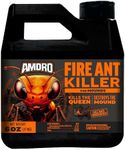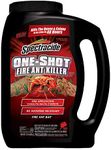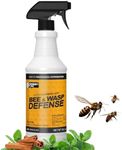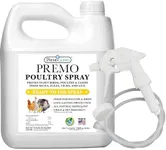Buying Guide for the Best Fire Ant Killing
Choosing the right product to kill fire ants can be a bit overwhelming given the variety of options available. The key to making the best choice is understanding the different specifications and how they align with your specific needs. Here are some important factors to consider when selecting a fire ant killer.Active IngredientThe active ingredient is the chemical component that kills the fire ants. This is important because different active ingredients work in different ways and have varying levels of effectiveness. Common active ingredients include hydramethylnon, spinosad, and bifenthrin. Hydramethylnon is effective but slower acting, making it suitable for long-term control. Spinosad is a natural substance that works quickly and is often preferred for organic gardening. Bifenthrin is a fast-acting synthetic chemical that provides quick results. Choose an active ingredient based on how quickly you need results and whether you prefer natural or synthetic options.
Formulation TypeFire ant killers come in various formulations such as granules, baits, sprays, and dusts. This specification is important because it affects how you apply the product and how it works. Granules are spread over the ground and watered in, making them ideal for large areas. Baits are carried back to the nest by worker ants, effectively targeting the entire colony. Sprays are used for direct application on visible ants and nests, providing immediate results. Dusts are applied to the nest and surrounding areas, offering long-lasting protection. Choose a formulation based on the size of the infested area and whether you need immediate or long-term control.
Application MethodThe application method refers to how the product is applied to the infested area. This is important because it affects ease of use and effectiveness. Common methods include broadcast spreading, mound treatment, and perimeter treatment. Broadcast spreading involves spreading the product over a large area, which is useful for widespread infestations. Mound treatment targets individual ant mounds, making it effective for localized infestations. Perimeter treatment involves applying the product around the perimeter of your property to prevent ants from entering. Choose an application method based on the extent of the infestation and your comfort level with applying the product.
Residual EffectThe residual effect refers to how long the product remains effective after application. This is important because it determines how often you need to reapply the product. Products with a long residual effect can provide protection for several months, reducing the need for frequent reapplication. Shorter residual effects may require more frequent treatments but can be useful for quickly addressing new infestations. Choose a product with a residual effect that matches your need for ongoing protection versus immediate results.
Safety for Pets and ChildrenSafety for pets and children is a crucial consideration if you have animals or young kids at home. This specification is important because some fire ant killers contain chemicals that can be harmful if ingested or touched. Look for products labeled as safe for use around pets and children, or consider using natural or organic options. Choose a product that ensures the safety of your household while effectively controlling the fire ant population.




















